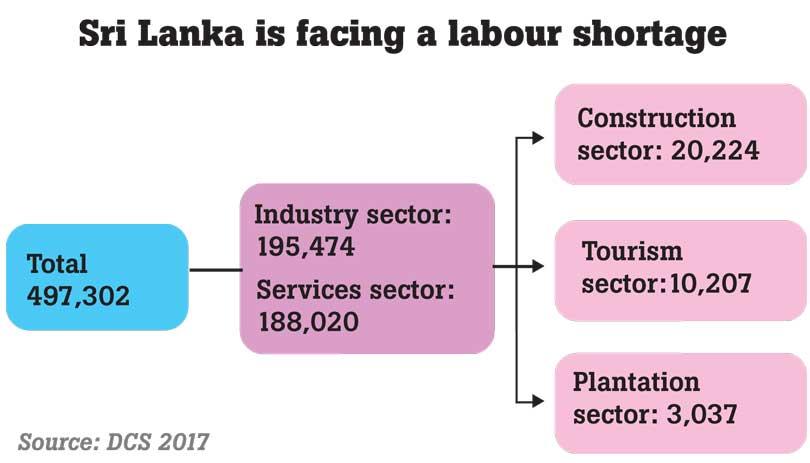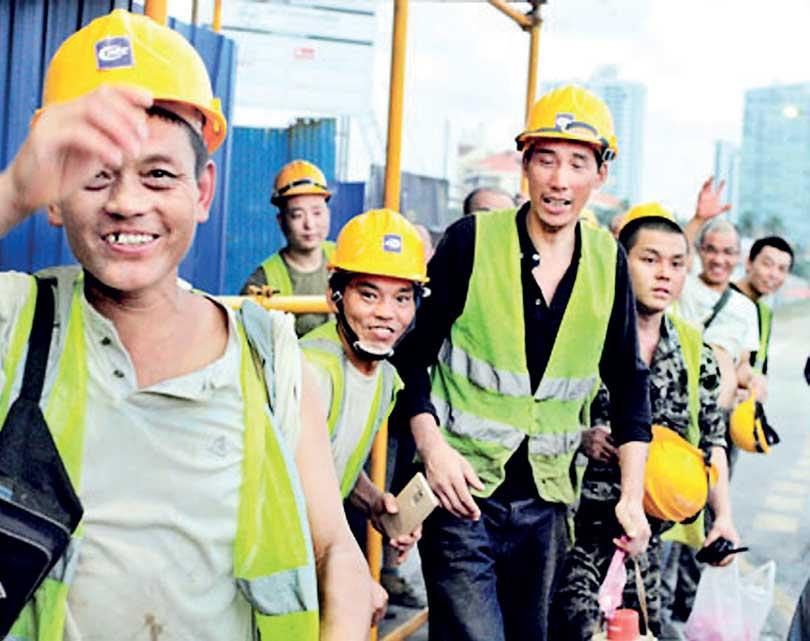27 Feb 2019 - {{hitsCtrl.values.hits}}

 Sri Lanka is today facing a domestic labour shortage in some key sectors and industries. Demographic issues, social attitudes, expansion of the economy and outward labour emigration are contributing to the shortfall. Generally, the lack of interest in certain types of jobs, low salaries and benefits, lack of qualified people and poor terms and conditions contribute to this overall shortage. Labour shortages are recorded in projects with foreign investments as well as in Sri Lankan-owned companies.
Sri Lanka is today facing a domestic labour shortage in some key sectors and industries. Demographic issues, social attitudes, expansion of the economy and outward labour emigration are contributing to the shortfall. Generally, the lack of interest in certain types of jobs, low salaries and benefits, lack of qualified people and poor terms and conditions contribute to this overall shortage. Labour shortages are recorded in projects with foreign investments as well as in Sri Lankan-owned companies.
According to the Census and Statistics Department, there were nearly half a million vacancies in medium and large-scale private sector enterprises in 2017. The hardest to fill vacancies are found in the occupation categories of sewing machine operators (46,576), security guards (45,316) and other manufacturing labours (31,277).
These findings are collaborated by industry-level studies, which indicate large-scale labour shortages in selected industries, including tourism, construction and information and communication.
Moreover, industry-level estimates show that the labour shortages are likely to increase over time.
Sri Lanka is now weighing its options in terms of importing workers from regional countries to combat a shortage of construction workers in the skilled, semi-skilled and unskilled categories
Sri Lanka is now weighing its options in terms of importing workers from regional countries to combat a shortage of construction workers in the skilled, semi-skilled and unskilled categories. While there is a general labour shortage of around 750,000 workers, the construction industry especially faces a major crisis, especially in terms of pending projects.
Although vocational training institutes have been set up by the government to train such workers, the youth who enrol see the perceived lack of dignity in construction work, risk of physical harm, poor superannuation benefits and fear of being unemployed once projects end, as some of the key reasons for the lack of interest of people in the construction industry.
The industry is said to be considering the import of labour from countries such as Nepal, Bangladesh and India. Some of them have already got a contingent of foreign workers to manage the shortfall.
Key input
As the skilled labour component is a key input to economic development, the consequences of not having the right skills leads to a productivity drop and direct output losses. Acute labour shortages affect growth ambitions and investor confidence. Economic research in other countries suggests unemployment below 5 percent builds wage pressure as businesses struggle to find suitable candidates.
Labour shortages – and the resulting higher costs – make markets inefficient and are a disincentive for investment. In the absence of a clear policy to deal with the issue of labour shortages, industries are adopting different strategies to overcome the problem. Some industries have resorted to hiring foreign workers to fill vacancies using foreign contractors.
Challenges
The industry estimates point to a large number of foreign workers mainly from India, China and Bangladesh, working in different sectors. Some industries are mechanizing operations while other industries have relocated their factories to other countries, for example to Bangladesh.
Notwithstanding all the economic benefits, labour import to any country is a politically sensitive issue, as it generally has far reaching political consequences. Some of the key issues include loss of job opportunities to locals due to cheaper labour cost, threats to social-cultural identity, health and disease, ethnic and religious disharmony and national security.
Unregulated labour immigration may also lead to illegal immigration, overstaying, abuse of visa conditions, risk of human trafficking resulting loss of public confidence in the immigration system. Sri Lanka currently has no proper institutional, legal, policy and operational framework for facilitating and regulating foreign workers into Sri Lanka. More than half a dozen government agencies are involved in the management of labour immigration and often without any coordination or centralization.
he industry estimates point to a large number of foreign workers mainly from India, China and Bangladesh, working in different sectors. Some industries are mechanizing operations while other industries have relocated their factories to other countries, for example to Bangladesh
Way forward
Today there is an urgent need for a coordinated approach to address this issue. The National Human Resources Development Council has formed a Taskforce on Labour Immigration with representatives from relevant government agencies to develop a strategy to transform the existing largely informal and irregular migration movements into a well-governed formal labour immigration system based on international norms that meets the demands of a strong, diversified economy.
In the final analysis, one of the key questions regarding immigration concerns its benefits and costs for the receiving economies. Fear that immigration may, at least in the short run, have adverse effects on the labour market opportunities of the young population and professionals are the main reason for the opposition in Sri Lanka. Finally the economic outcomes of immigration depend crucially on the skill structure of immigrants relative to the skill structure of the locals.

(Dinesh Weerakkody is a thought leader)
15 Nov 2024 5 hours ago
15 Nov 2024 6 hours ago
15 Nov 2024 7 hours ago
15 Nov 2024 8 hours ago
15 Nov 2024 8 hours ago